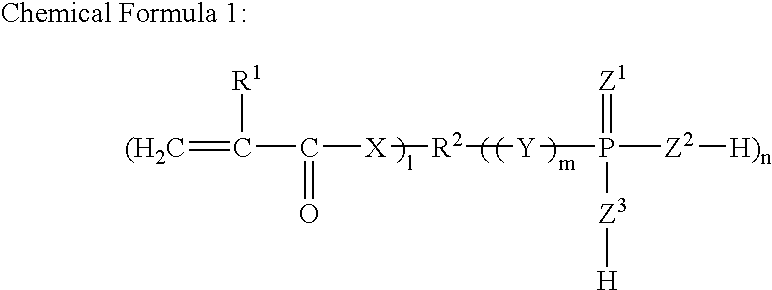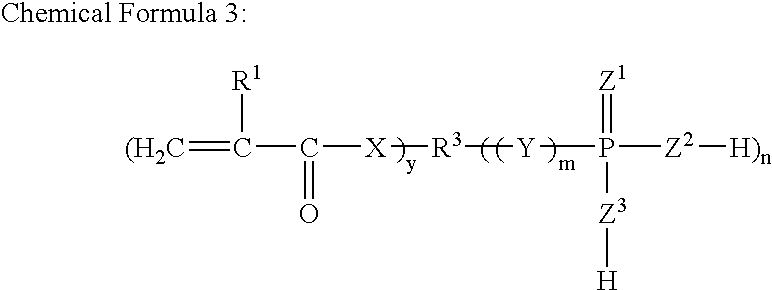Redox Curing-Type Nonaqueous Curable Composition
- Summary
- Abstract
- Description
- Claims
- Application Information
AI Technical Summary
Benefits of technology
Problems solved by technology
Method used
Image
Examples
embodiment 1
[0068]Agents A1-1 and A1-2 having compositions described below were prepared and combined, so as to produce a divided type nonaqueous curable composition (present composition) including these agents in a weight ratio of 1:1. In the composition obtained by mixing the agents A1-1 and A1-2, sodium sulfite was in a dispersed state. The divided type nonaqueous curable composition was subjected to a curing time test (P1) and a tensile bond strength test (Q1) described below, so as to obtain a curing time and tensile bond strength. The results are listed in Table 1 below. It is noted that the average particle diameter of a powdered water-soluble reducing compound (that is, a sodium sulfite powder in Embodiment 1) was measured by using ethanol as a dispersing medium with a laser diffraction particle size analyzer SALD-2100 (manufactured by Shimadzu Corporation) (which measurement method was similarly employed in other embodiments below).
[0069]Agent A1-1:
Bis-GMA40 parts by weightHEMA20 parts...
embodiment 2
[0073]An agent A2-2 having a composition described below was prepared by replacing 3 parts by weight of a sodium sulfite powder of the agent A1-2 of Embodiment 1 with 2 parts by weight of a potassium sulfite powder, and the agent A2-2 was combined with the agent A1-1 of Embodiment 1, so as to produce a divided type nonaqueous curable composition (present composition) including these agents in a weight ratio of 1:1. In the composition obtained by mixing the agents A2-2 and A1-1, potassium sulfite was in a dispersed state. This divided type nonaqueous curable composition was subjected to the aforementioned curing time test (P1) and tensile bond strength test (Q1) so as to obtain a curing time and tensile bond strength. The results are listed in Table 1 below.
[0074]Agent A2-2:
Bis-GMA40 parts by weightHEMA40 parts by weightTEGDMA20 parts by weightPotassium sulfite powder (with 2 parts by weightan average particle diameterof 9.9 μm)
embodiment 3
[0080]Agents B1-1 and B1-2 having compositions described below were prepared and combined, so as to produce a divided type nonaqueous curable composition (present composition) including these agents in a weight ratio of 1:1. In the composition obtained by mixing the agents B1-1 and B1-2, sodium sulfite was in a dispersed state. This divided type nonaqueous curable composition was subjected to the aforementioned curing time test (P1) for obtaining a curing time and was also subjected to a tensile bond strength test (Q2) described below for obtaining tensile bond strength. The results are listed in Table 2 below.
[0081]Agent B1-1:
Bis-GMA40 parts by weightHEMA30 parts by weightNPG30 parts by weightBPO1 part by weight
[0082]Agent B1-2:
Bis-GMA40 parts by weightHEMA30 parts by weightNPG30 parts by weightSodium sulfite powder (with an average1 part by weightparticle diameter of 6.1 μm)
[Tensile Bond Strength Test (Q2)]
[0083]The labial surface of a lower anterior tooth of a bovine was polished...
PUM
| Property | Measurement | Unit |
|---|---|---|
| Percent by mass | aaaaa | aaaaa |
| Percent by mass | aaaaa | aaaaa |
| Percent by mass | aaaaa | aaaaa |
Abstract
Description
Claims
Application Information
 Login to View More
Login to View More - R&D
- Intellectual Property
- Life Sciences
- Materials
- Tech Scout
- Unparalleled Data Quality
- Higher Quality Content
- 60% Fewer Hallucinations
Browse by: Latest US Patents, China's latest patents, Technical Efficacy Thesaurus, Application Domain, Technology Topic, Popular Technical Reports.
© 2025 PatSnap. All rights reserved.Legal|Privacy policy|Modern Slavery Act Transparency Statement|Sitemap|About US| Contact US: help@patsnap.com



